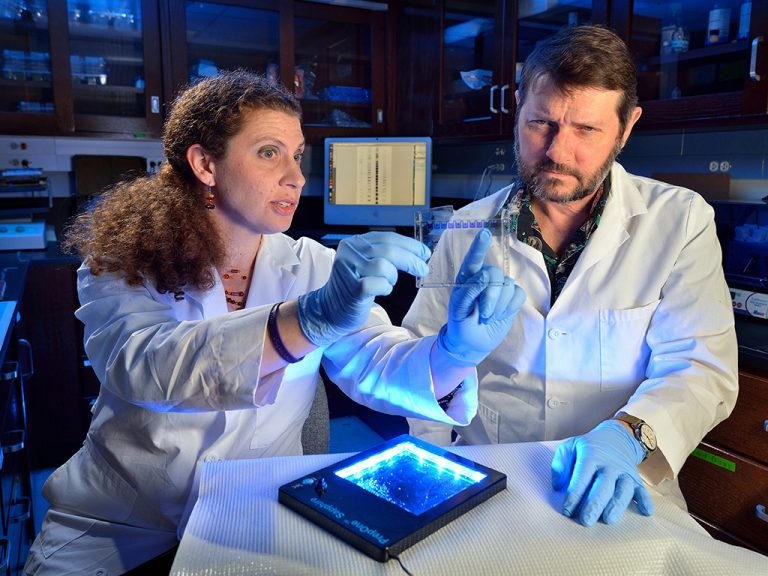University included in several rankings of the nation’s and world’s best institutions
FEBRUARY 21, 2017 BY

The University of Mississippi is ranked among the nation’s best public institutions in several third-party evaluations of academic and research performance. Photo by Robert Jordan/UM Communications
Efforts by faculty, staff and students to excel in their pursuit of knowledge have given the University of Mississippi, the state’s flagship university, new momentum in its mission to lead the way in learning, discovery and engagement for the state and nation.
UM has been ranked among the nation’s best public institutions in several third-party evaluations of academic and research performance, and the university has climbed in recent measures of those areas.
In 2016, the university was included for the first time among the elite group of R1: Doctoral Universities – Highest Research Activity by the Carnegie Classification of Institutions of Higher Education, the definitive list of the nation’s top doctoral research universities. UM is among a distinguished group of 115 institutions, including Harvard, MIT and Johns Hopkins in the highest research category, which includes the top 2.5 percent of institutions of higher education.
The university also achieved its highest-ever standing in the 2017 U. S. News & World Report annual rankings of Best (Undergraduate) Colleges and Universities, where UM tied for No. 64 in the Top Public Universities category, up seven places from the previous year’s rankings. The rankings reflect 15 indicators of academic excellence, such as graduation and retention rates, undergraduate academic reputation, faculty resources, financial resources and alumni giving rates.
The business (including accounting) and engineering programs were also ranked nationally.
“These achievements and rankings reinforce our flagship status and are a testament to the value of our degrees, the impact of our research and the competitiveness of our students, staff and faculty,” Chancellor Jeffrey Vitter said. “While they provide important benchmarks for our university, we remain committed to achieving even higher levels of excellence.
“We will focus upon growing the reach and impact of Ole Miss to continue making a positive difference for Mississippi, our nation and the world.”
The university ranked in the top 20 percent of U.S. institutions for total research and development expenditures in a report issued by the National Science Foundation based upon 2015 expenditures. For the 10th consecutive year, the university was ranked in the top 20 percent in this report.
The university also performed well in the inaugural ranking of U.S. colleges and universities by The Wall Street Journal and Times Higher Education publications. This measure ranked UM 74th among all the nation’s public universities.
This ranking constitutes a comparative assessment of more than 1,000 colleges and universities, measuring factors such as university resources, student engagement, outcomes and environment. The latter includes a gauge of the university’s efforts to build a diverse and inclusive environment for students, faculty and staff.
“Many of our academic offerings continue to gain exposure and recognition,” said Noel Wilkin, the university’s interim provost and executive vice chancellor. “I fully expect this trend to continue because of the quality and commitment of our faculty and staff.”
Success in international education and research partnerships contributed to the university’s standing on U.S. News’ 2017 list of Best Global Universities. Among the top 1,000 research universities in 65 countries, UM ranked in the top third on this year’s list.

Randy Wadkins, professor of chemistry and biochemistry, and Tracy Brooks (left), assistant professor of pharmacology, discuss their progress on an anticancer research project at UM. Photo by Robert Jordan/UM Communications
The Best Global Universities list ranks each institution’s international and regional research reputation, including a statistical analysis of peer-reviewed publications, citations and international collaborations. The university ranked in the top 10 percent in international collaborations, and the university’s research areas of physics and pharmacology/toxicology were ranked in the top 20 percent.
“The reputation of the university in national and international research circles has been steadily growing over the past few decades,” said Josh Gladden, interim vice chancellor for research and sponsored programs and associate professor of physics and astronomy. “We have seen this trend through an increasing number of national leadership positions in societies and consortia, an increase in the number of grant awards, as well as in statistical reports such as U.S. News and World Report.
“It is an exciting time for the research community at the university, and I look forward to increasingly higher impact of UM research.”
U.S. News and World Report ranked two of the university’s graduate academic programs in the top 25 nationally among public universities: the online MBA program (No. 19) and pharmacy (No. 23). Here are some of the other U.S. News rankings of UM graduate programs among public universities:
- School of Education online program (tied No. 35)
- Arch Dalrymple III Department of History (tied No. 48)
- Master of Business Administration (tied No. 51)
- English (tied No. 56)
- Clinical psychology (tied No. 67)
- Civil engineering (tied No. 70)
- Education (tied No. 72)
- Social work (tied No. 77)
- Physics (tied No. 84)
- Electrical engineering (tied No. 85)
- Mathematics (tied No. 91)
In national rankings by other sources, the university achieved several additional accolades among all public and private universities:
- Patterson School of Accountancy (all three degree programs ranked in the top 10 nationally by the journal Public Accounting Report)
- Patterson School of Accountancy master’s and doctoral programs (No. 1 in SEC)
- Patterson School of Accountancy undergraduate program (No. 2 in SEC)
- Creative Writing (No. 6 among “Top 10 Universities for Aspiring Writers” by CollegeMagazine.com)
- Online health informatics undergraduate program (No. 3 by the Health Informatics Degree Center)
- Business law program in the School of Law (one of only four schools to earn a perfect score of A+ by preLaw Magazine, ranking it as one of the country’s top programs)
The university’s efforts to achieve excellence in all its endeavors also has helped recruit talented students to learn and contribute on all its campuses. The Chronicle of Higher Education named the university as the nation’s eighth-fastest growing among both public and private colleges in its Almanac of Higher Education, moving up from 13th in 2014.
The ranking is based upon enrollment growth from fall 2006, when the university enrolled 14,497 students, to fall 2016, with 24,250 students registered.
The university’s incoming freshmen continue to be better-prepared for the rigor of college, posting an average ACT score of 25.2 in fall 2016, surpassing the school record of 24.7 set in 2015. The high school GPA of incoming freshmen also increased, growing from 3.54 to 3.57, another university record.
“Ole Miss is committed to student success,” Vitter said. “The demand for a University of Mississippi degree is unprecedented, and the success of our programs and initiatives aimed at helping students stay in school and graduate is clear in our increasing retention and graduation rates.
“Each and every day, our faculty and staff demonstrate strong commitment to transforming lives through higher education.”